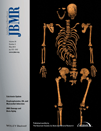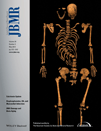J BONE MINER RES:运动能延缓骨癌生长
2013-05-10 Alexa 医学论坛网
? 微型三维CT重建的对比组和注射瘤体组胫骨(负重与不负重) 负重运动可以对抗骨质流失,某种程度上起到抗癌的效果。康奈尔生物医学研究人员报告称,可以通过机械刺激骨头,增强正常骨细胞功能,削弱肿瘤细胞破坏力。 在动物和体外模型上的实验均表明,让骨头反复承重与运动疗法类似,抑制由转移乳腺癌细胞组成的骨癌细胞的生长。研究人

微型三维CT重建的对比组和注射瘤体组胫骨(负重与不负重)
负重运动可以对抗骨质流失,某种程度上起到抗癌的效果。康奈尔生物医学研究人员报告称,可以通过机械刺激骨头,增强正常骨细胞功能,削弱肿瘤细胞破坏力。
在动物和体外模型上的实验均表明,让骨头反复承重与运动疗法类似,抑制由转移乳腺癌细胞组成的骨癌细胞的生长。研究人员认为,这样的机械刺激或能抑制那些干扰正常健康骨头功能的基因的表达。
Maureen Lynch博士和生物医学工程副教授兼资深作家Claudia Fischbach-Teschl 领导了这项研究,相关研究成果与5月3日在线发布于《骨与矿物质研究杂志》上。
乳腺癌好转移到骨头上,由于肿瘤干扰正常骨重建的过程,病情进一步恶化。随之而来的是骨质流失,骨质溶解,出现裂骨。这种环境下有助于供养肿瘤,因为这些裂骨是生长因子的仓库。退化的骨会释放这些存储的生长因子,促进肿瘤细胞不断生长。
Marjolein van der Meulen 实验室和康奈尔生物医学工程擅长研究骨生物力学的Swanson教授发起的一项骨“负重模型”的研究表明,肿瘤对机械刺激有反应。

胫骨相应的组织学横截面显示,无载荷肿瘤胫骨展示溶骨性退化和广泛的肿瘤形成,而负载的则抑制了这些变化。
与运动相关的拓展阅读:
- J BONE MINER RES:运动能延缓骨癌生长
- Chest:运动训练可提高肺动脉高压患者的心肺功能和生活质量
- Stroke:超高龄患者的运动和认知能力影响对血压与卒中之间的相关性
- Neuron:揭示V4脑区对视觉运动信息的处理
- 饮食失调过量运动可预测自杀行为
- 运动后易“损伤”警惕骨肿瘤 更多信息请点击:有关运动更多资讯

Exercise could reduce bone tumor growth
Weight-bearing exercise, often prescribed to combat bone loss, might have anti-cancer effects. Cornell biomedical researchers report that mechanical stimulation of cancerous bone, in making bone stronger, seems to make tumors weaker.
The study, which involved both animal and in vitro models, showed that causing bone to bear moderate, repeated weight – akin to an exercise regimen – led to inhibited growth of bone tumors composed of metastasized breast cancer cells. The researchers think that such mechanical stimulation might reduce the expression of genes that interfere with normal, healthy bone functioning.
Published online May 3 by the Journal of Bone and Mineral Research, the study was led by first author and postdoctoral researcher Maureen Lynch and senior author Claudia Fischbach-Teschl, associate professor of biomedical engineering.
Breast cancer often metastasizes to bone, which then deteriorates because a tumor disturbs the normal process of bone remodeling. The subsequent bone loss, which is caused by too much bone breakdown known as osteolysis, helps feed the tumor, because the bone is a depot of factors that promote tumor growth. Degraded bone releases these stored factors, and the tumor grows.
The researchers used a bone “loading model” to show that tumors respond to mechanical stimulation. The loading model originated in the lab of paper co-author Marjolein van der Meulen, the Swanson Professor of Biomedical Engineering at Cornell, who studies biological mechanics particularly in bone.
The experiments showed that loading of a mouse tibia injected with malignant breast cancer cells – recreating the metastatic condition – kept the tumor from growing and increased bone mass. Doing nothing allowed the tumor to proliferate and the bone to degrade.
“If you think about typical cancer treatment, like chemotherapies, they are targeting the cancer cells,” Lynch said. “So we needed to figure out if loading is affecting the tumor cells in addition to the bone cells, or if this is some kind of indirect effect. We found a little bit of both.”
To control microenvironmental factors, the researchers did other experiments with a 3-D tumor model designed in Fischbach-Teschl’s lab. They injected tumor cells into a porous scaffold that looks like an aspirin pill, then loaded the cells by using a piston to squeeze the scaffold. They examined how different genes characteristic of tumor cells were expressed as the loading occurred.
Genes involved in cancer were largely unaffected, except one, called Runx2, a transcription factor that regulates gene expression and production of other proteins. This, in turn, affects what bone cells are doing.
In a cancer cell, the researchers have theorized, Runx2 directs the cells to secrete proteins that stimulate osteolysis, too much of which leads to bone loss. Mechanical loading inhibits expression of Runx2, and they think that’s why proteins that affect osteolysis are also reduced. Further experimentation to confirm this theory is needed.
The insights from this paper could lead not only to drug therapies but also to more targeted exercise regimens for cancer patients, Fischbach-Teschl said.
“Specifically, physically mediated mechanisms in bone might be contributing to bone loss in cancer patients,” she said. “So harnessing those things better is what could really help patients.”
The paper is titled “In Vivo Tibial Compression Decreases Osteolysis and Tumor Formation in Human Metastatic Breast Cancer Model.” The work was supported by the National Institutes of Health and The Hartwell Foundation.
本网站所有内容来源注明为“梅斯医学”或“MedSci原创”的文字、图片和音视频资料,版权均属于梅斯医学所有。非经授权,任何媒体、网站或个人不得转载,授权转载时须注明来源为“梅斯医学”。其它来源的文章系转载文章,或“梅斯号”自媒体发布的文章,仅系出于传递更多信息之目的,本站仅负责审核内容合规,其内容不代表本站立场,本站不负责内容的准确性和版权。如果存在侵权、或不希望被转载的媒体或个人可与我们联系,我们将立即进行删除处理。
在此留言








#Bone#
52
#骨癌#
98